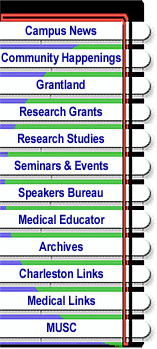


|
Fibroids treated with less invasive techniqueby Cindy AbolePublic Relations Karen Eippert wasn’t prepared for the startling news from her gynecologist after being diagnosed with uterine fibroids in 1997. In fact, she refused to accept his recommendation of a hysterectomy, a surgical procedure that involves the removal of a woman’s uterus or womb, as the final solution for her medical outcome. Instead, Eippert became her own advocate-educating herself and conferring with a supportive interdisciplinary team of physicians who led her to an established technique that has gynecologists and interventional radiologists buzzing.
“Reports have shown that more than 90 percent of women who undergo uterine artery embolization are satisfied,” said Bayne Selby, MD., professor of radiology and co-director of the interventional radiology division. “The embolization technique is identical to what we do everyday for other procedures. The only thing new is why we’re doing it, which in this case is to provide a less invasive technique, bring comfort to the patient and allow a woman to keep her uterus." Eippert first read about the technique in a magazine article that promoted embolization successes at UCLA’s interventional radiology program. After conducting her own web search and information gathering, she consulted with Melisa Holmes, M.D., assistant professor of Obstetrics and Gynecology, about the popular procedure. Holmes referred her to Selby and together they reviewed her case and scheduled Eippert as a patient last December. So far, Selby has treated 11 patients with the uterine artery embolization procedure. “When we first looked into creating the program, we decided to do this as a collaborative effort between two departments, OB/GYN and Interventional Radiology, because it’s the only way to ensure a patient will get the best care,” Selby said. “We think patients need a collaborative approach. That’s an advantage we have here at MUSC.” The procedure requires the use of an arteriogram to help map out the blood supply to the uterus and the fibroids. Next, a catheter is inserted into the arteries and small particles of polyvinyl alcohol (PVA) are injected into the uterine artery. Because the uterus has such a rich blood supply, it doesn’t die. Only small amounts of PVA (about 300 to 500 microns in size) are needed. These permanent particles weave their way to the smaller blood vessels that lead to the fibroids, plugging them up and eventually killing it. Selby performs the procedure within the comfort of an interventional radiology treatment suite. Afterwards, the patient may experience a varying degree of side effects that might include pain, cramping and nausea, which can be controlled with intravenous medications. Although patients only stay in the hospital overnight, it’s estimated that the total recovery period can last anywhere from 4 to 7 days. “The beauty in this procedure is that the patient defines success,” Selby said. “The procedure is done in response to the patient’s symptoms. If we do the procedure and the patient no longer has any symptoms, no further treatment is required.” “I knew I wanted to explore my options after my uterine fibroid diagnosis,” said Eippert. “I wanted to avoid the anxiety and risks of a major surgery by exploring other alternatives. It’s a great thing for women today to find other options for treatment.” For information, visit the interventional radiology website at <http://www.musc.edu/radiology/interventional> or call 792-5300. |